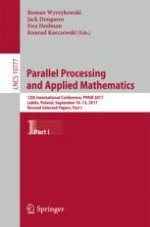The two-volume set LNCS 10777 and 10778 constitutes revised selected papers from the 12th International Conference on Parallel Processing and Applied Mathematics, PPAM 2017, held in Lublin, Poland, in September 2017.
The 49 regular papers presented in this volume were selected from 98 submissions. For the workshops and special sessions, that were held as integral parts of the PPAM 2017 conference, a total of 51 papers was accepted from 75 submissions.
The papers were organized in topical sections named as follows:
Part I: numerical algorithms and parallel scientific computing; particle methods in simulations; task-based paradigm of parallel computing; GPU computing; parallel non-numerical algorithms; performance evaluation of parallel algorithms and applications; environments and frameworks for parallel/distributed/cloud computing; applications of parallel computing; soft computing with applications; and special session on parallel matrix factorizations.
Part II: workshop on models, algorithms and methodologies for hybrid parallelism in new HPC systems; workshop power and energy aspects of computations (PEAC 2017); workshop on scheduling for parallel computing (SPC 2017); workshop on language-based parallel programming models (WLPP 2017); workshop on PGAS programming; minisymposium on HPC applications in physical sciences; minisymposium on high performance computing interval methods; workshop on complex collective systems.
